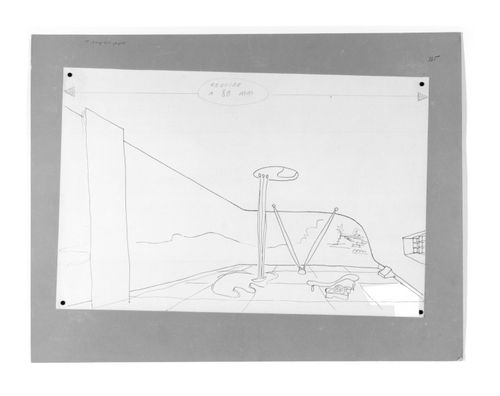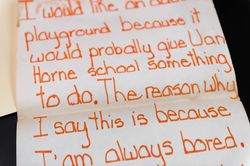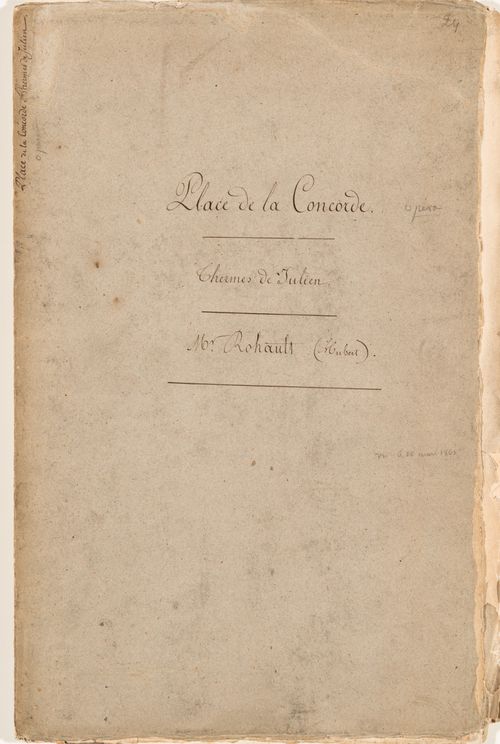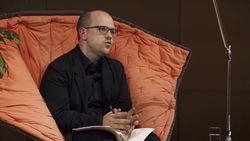DR1996:0002
Description:
- Two groups of four pastel drawings were originally produced in connection with the Village Polychrome project. The architect André Bruyère had retained one group, while the other was given to the patron and client, Francisco de Assis Chateaubriand Bandeira de Melo, who then donated it to the Sao Paolo Museum of Modern Art. Bruyère subsequently gave one of the four drawings in his group to a friend. The three remaining drawings from Bruyère's group are in the CCA Prints and Drawings collection (DR1996:0001 - DR1996:0003) ("Projet de Village Polychrome, Biot, France"). - The sliding wall, shown on the left, can be used to partially enclose the terrace ("Village d'artistes sur la Côte d'Azur", p. 83).
interior design
1953
Perspective for a guest villa showing the terrace, Village Polychrome, near Biot, France
Actions:
DR1996:0002
Description:
- Two groups of four pastel drawings were originally produced in connection with the Village Polychrome project. The architect André Bruyère had retained one group, while the other was given to the patron and client, Francisco de Assis Chateaubriand Bandeira de Melo, who then donated it to the Sao Paolo Museum of Modern Art. Bruyère subsequently gave one of the four drawings in his group to a friend. The three remaining drawings from Bruyère's group are in the CCA Prints and Drawings collection (DR1996:0001 - DR1996:0003) ("Projet de Village Polychrome, Biot, France"). - The sliding wall, shown on the left, can be used to partially enclose the terrace ("Village d'artistes sur la Côte d'Azur", p. 83).
interior design
DR1996:0011
Description:
- Two groups of four pastel drawings were originally produced in connection with the Village Polychrome project. The architect André Bruyère had retained one group, while the other was given to the patron and client, Francisco de Assis Chateaubriand Bandeira de Melo, who then donated it to the Sao Paolo Museum of Modern Art. Bruyère subsequently gave one of the four drawings in his group to a friend. The three remaining drawings from Bruyère's group are in the CCA Prints and Drawings collection (DR1996:0001 - DR1996:0003) ("Projet de Village Polychrome, Biot, France"). - The sliding wall, shown on the left, can be used to partially enclose the terrace ("Village d'artistes sur la Côte d'Azur", p. 83).
interior design
1952-1953
Perspective for a guest villa showing the terrace, Village Polychrome, near Biot, France
Actions:
DR1996:0011
Description:
- Two groups of four pastel drawings were originally produced in connection with the Village Polychrome project. The architect André Bruyère had retained one group, while the other was given to the patron and client, Francisco de Assis Chateaubriand Bandeira de Melo, who then donated it to the Sao Paolo Museum of Modern Art. Bruyère subsequently gave one of the four drawings in his group to a friend. The three remaining drawings from Bruyère's group are in the CCA Prints and Drawings collection (DR1996:0001 - DR1996:0003) ("Projet de Village Polychrome, Biot, France"). - The sliding wall, shown on the left, can be used to partially enclose the terrace ("Village d'artistes sur la Côte d'Azur", p. 83).
interior design
Reading the Archive Out Loud
An archive is usually named for one person, but it always contains many other voices. On 12 July, 30 August, and 27 September, CCA staff and special guests read letters written by children, threatening lawyers, architects trying to manage disasters, as well as lectures that were never delivered, from the archives of Cornelia Hahn Oberlander and James Stirling and Michael(...)
Parc Baile
12 July 2018, 6:30pm
Reading the Archive Out Loud
Actions:
Description:
An archive is usually named for one person, but it always contains many other voices. On 12 July, 30 August, and 27 September, CCA staff and special guests read letters written by children, threatening lawyers, architects trying to manage disasters, as well as lectures that were never delivered, from the archives of Cornelia Hahn Oberlander and James Stirling and Michael(...)
Parc Baile
DR1974:0002:037:001-031
Description:
- This album contains drawings, prints and manuscripts chiefly related to two projects: the restoration of the Thermes de Julien and the development of the place de la Concorde, then known as place Louis XV. The ruins of the baths are documented in five drawings by Hubert Rohault de Fleury. The portfolio of manuscripts includes letters from the "Préfecture du Départment de la Seine" appointing Hubert Rohault de Fleury and Etienne Goddes to direct the restoration of the baths, a report by Rohault de Fleury and Goddes, and subsequent letters. The report includes a description of the baths, historical research, suggestions for earth removal and the purchase of adjacent buildings to be demolished. Both proposals made by Hubert Rohault de Fleury to the "Ministre de l'interior" for place Louis XV include central fountains and streets bisecting the square into four quadrants, each with fenced lawns and central fountains. One proposal shows the outer corner of each quadrant bordered by colonnades and loggias overlooking the "jardins des Tuileries", while the other proposal shows promenades bordered by a row of sculptures (DR1974:0002:037:004 - DR1974:0002:037:013). Also by Hubert Rohault de Fleury are several sketches for urban squares and five sketches for fountains, probably for place Louis XV (DR1974:0002:037:003, DR1974:0002:037:014 R/V - DR1974:0002:037:018 R/V). Projects by other architects for place Louis XV in the album include: a print by an unknown engraver of a project by Poyet for place Louis XV, including an opera house; engravings by Ollivier and Hibon of plans and fountains for place Louis XVI by Destouches and by Lusson; a lithograph by Roux of an obelisk with a fountain, probably a proposal for the base of the obelisk from Luxor. - Material unrelated to the Thermes de Julien and place Louis XV in this album includes one sheet of sketches of plans and elevations of unidentified buildings (DR1974:0002:037:001:045 R/V) and a plan showing the location of trees on the edge of place du Cirque Olympique, Paris (DR1974:0002:037:025). In addition to place Louis XVI, the engravings by Hibon and Ollivier depict a fountain for the ville de Toulouse designed by either Etienne Jacques or Etienne Jules Tierry and details of the acanthus foliage finial of the "Lanterne de Démosthénes", often known as the Choragic monument of Lysicrates, Greece (DR1974:0002:037:020 and DR1974:0002:037:021).
architecture, urban planning
1754-1875
Album of drawings, prints and documents for place de la Concorde and the restoration of the Thermes de Julien, Paris
Actions:
DR1974:0002:037:001-031
Description:
- This album contains drawings, prints and manuscripts chiefly related to two projects: the restoration of the Thermes de Julien and the development of the place de la Concorde, then known as place Louis XV. The ruins of the baths are documented in five drawings by Hubert Rohault de Fleury. The portfolio of manuscripts includes letters from the "Préfecture du Départment de la Seine" appointing Hubert Rohault de Fleury and Etienne Goddes to direct the restoration of the baths, a report by Rohault de Fleury and Goddes, and subsequent letters. The report includes a description of the baths, historical research, suggestions for earth removal and the purchase of adjacent buildings to be demolished. Both proposals made by Hubert Rohault de Fleury to the "Ministre de l'interior" for place Louis XV include central fountains and streets bisecting the square into four quadrants, each with fenced lawns and central fountains. One proposal shows the outer corner of each quadrant bordered by colonnades and loggias overlooking the "jardins des Tuileries", while the other proposal shows promenades bordered by a row of sculptures (DR1974:0002:037:004 - DR1974:0002:037:013). Also by Hubert Rohault de Fleury are several sketches for urban squares and five sketches for fountains, probably for place Louis XV (DR1974:0002:037:003, DR1974:0002:037:014 R/V - DR1974:0002:037:018 R/V). Projects by other architects for place Louis XV in the album include: a print by an unknown engraver of a project by Poyet for place Louis XV, including an opera house; engravings by Ollivier and Hibon of plans and fountains for place Louis XVI by Destouches and by Lusson; a lithograph by Roux of an obelisk with a fountain, probably a proposal for the base of the obelisk from Luxor. - Material unrelated to the Thermes de Julien and place Louis XV in this album includes one sheet of sketches of plans and elevations of unidentified buildings (DR1974:0002:037:001:045 R/V) and a plan showing the location of trees on the edge of place du Cirque Olympique, Paris (DR1974:0002:037:025). In addition to place Louis XVI, the engravings by Hibon and Ollivier depict a fountain for the ville de Toulouse designed by either Etienne Jacques or Etienne Jules Tierry and details of the acanthus foliage finial of the "Lanterne de Démosthénes", often known as the Choragic monument of Lysicrates, Greece (DR1974:0002:037:020 and DR1974:0002:037:021).
architecture, urban planning
Project
AP178.S1.1984.PR02
Description:
The project series documents the Punt en Komma social housing project in The Hague, The Netherlands, with some materials related to the Urban plan for Deelgebied Zone 5, Schilderswijk-West. While the records were held in the office’s archives the urban plan for Deelgebied Zone 5 was assigned the number 30/80 and Punt en Komma was assigned the number 30/80 A/B (Punt (A) and Komma (B)). The office assigned the date 1984 for this project. In the mid to late1970s The Hague underwent an urban renewal program and in 1980 Adri Duivesteijn became the alderman responsible for this program. Dissatisfied with the results, in the early to mid-1980s Duivesteijn began a campaign to look at urban renewal as a cultural approach, and was interested in the participatory process that Siza incorporated for the Serviço Ambulatório de Apoio Local (SAAL) in Portugal and the Berlin projects submitted to the International Architectural Exhibition Berlin competition (International Bauaustellung, IBA, circa 1979-1987). After taking a trip to Portugal, Duivesteijn invited Siza to speak with residents of Schilderswijk. The urban plan for Schilderswijk was the first part of a redevelopment plan for the 19th century district and included two four story blocks of 106 apartments, named Punt en Komma. Schilderswijk is in the centre of The Hague and is nearby the Haag Spoor train station. The residents are made up of multi-ethnic communities and included immigrants from Turkey, Morocco, Tunisia, and Portugal. Similarly to the Berlin projects, Siza was faced with cultural tensions between the residents of the area. The urban plan was to take into account the preservation of the neighborhood's identity while accounting for the changes brought on by multi-ethnic communities. As with the SAAL and Berlin projects there was an element of participation from the residents and included the collaboration of a residents association. In the “Plan of Zone 5 of Schilderswijk Centrum…”, found in this project series [AP178.S1.1984.PR02.024.1, AP178.S1.1984.PR02.024.2], it is outlined that meetings were periodically held with technicians appointed by the Department of Urban Planning and Housing of The Hague, the Housing Cooperative, and each of the designers. Siza’s design for Punt en Komma incorporated elements prevalent in Dutch architecture such as the Haagse Portiek. However, he also included components in his design which accounted for the needs of residents living there at the time. One feature which gained much attention was the incorporation of sliding doors in the apartments. Siza included these doors in his design in consideration of the cultural practices of Muslim families. Documenting this project series are drawings, photographic materials, and textual documentation. Among the drawings are plans, elevations, sections, and details, as well as axonometric drawings, such as the proposed design for Deelgebied zone 5 (including Punt en Komma) and drawings of the Haagse Porteik. Photographic materials document both Duivesteijn’s trip to Portugal and Siza’s first trip to The Hague and include photographs, negatives, and slides of the built project, as well as slides of drawings. Note that the photographic materials include photographs related to the housing and shopping complex in Schilderswijk. Textual documentation includes brochures regarding rent increases, a copy of “Stadsvernieuwing als Kulturele Aktiviteit” by Duivesteijn, and information booklets for the residents. Also included are minutes of meeting and correspondence from the Woningbouwvereniging’s-Gravenhage. Among the correspondence are letters regarding construction costs, including a letter from Siza to the local architectural firm Architectengemeenschap Van den Broek en Bakema explaining that he does not wish to modify the detail he specified for the lintels of the Punt building. There is also correspondence from project architect Carlos Castenheira and Duivesteijn and a summary of the meeting between Siza and the Committee of the Corporation for Social Housing (17 April, 1985)[AP178.S1.1984.PR02.025.1] It is important to note that Siza also participated in other projects for this urban renewal program: the housing and shopping complex in Schilderswijk [AP178.S1.1984.PR03], the Van der Vennepark [AP178.S1.1985.PR01], and the residential settlement in Schilderswijk (Plano de Doedijnstraat [AP178.S1.1989.PR03]). All three of these projects are arranged in separate project series.
circa 1981 - 1990
106 habitações, Punt en Komma [Punt en Komma social housing], Schilderswijk-West, The Hague, The Netherlands, (1981-1990)
Actions:
AP178.S1.1984.PR02
Description:
The project series documents the Punt en Komma social housing project in The Hague, The Netherlands, with some materials related to the Urban plan for Deelgebied Zone 5, Schilderswijk-West. While the records were held in the office’s archives the urban plan for Deelgebied Zone 5 was assigned the number 30/80 and Punt en Komma was assigned the number 30/80 A/B (Punt (A) and Komma (B)). The office assigned the date 1984 for this project. In the mid to late1970s The Hague underwent an urban renewal program and in 1980 Adri Duivesteijn became the alderman responsible for this program. Dissatisfied with the results, in the early to mid-1980s Duivesteijn began a campaign to look at urban renewal as a cultural approach, and was interested in the participatory process that Siza incorporated for the Serviço Ambulatório de Apoio Local (SAAL) in Portugal and the Berlin projects submitted to the International Architectural Exhibition Berlin competition (International Bauaustellung, IBA, circa 1979-1987). After taking a trip to Portugal, Duivesteijn invited Siza to speak with residents of Schilderswijk. The urban plan for Schilderswijk was the first part of a redevelopment plan for the 19th century district and included two four story blocks of 106 apartments, named Punt en Komma. Schilderswijk is in the centre of The Hague and is nearby the Haag Spoor train station. The residents are made up of multi-ethnic communities and included immigrants from Turkey, Morocco, Tunisia, and Portugal. Similarly to the Berlin projects, Siza was faced with cultural tensions between the residents of the area. The urban plan was to take into account the preservation of the neighborhood's identity while accounting for the changes brought on by multi-ethnic communities. As with the SAAL and Berlin projects there was an element of participation from the residents and included the collaboration of a residents association. In the “Plan of Zone 5 of Schilderswijk Centrum…”, found in this project series [AP178.S1.1984.PR02.024.1, AP178.S1.1984.PR02.024.2], it is outlined that meetings were periodically held with technicians appointed by the Department of Urban Planning and Housing of The Hague, the Housing Cooperative, and each of the designers. Siza’s design for Punt en Komma incorporated elements prevalent in Dutch architecture such as the Haagse Portiek. However, he also included components in his design which accounted for the needs of residents living there at the time. One feature which gained much attention was the incorporation of sliding doors in the apartments. Siza included these doors in his design in consideration of the cultural practices of Muslim families. Documenting this project series are drawings, photographic materials, and textual documentation. Among the drawings are plans, elevations, sections, and details, as well as axonometric drawings, such as the proposed design for Deelgebied zone 5 (including Punt en Komma) and drawings of the Haagse Porteik. Photographic materials document both Duivesteijn’s trip to Portugal and Siza’s first trip to The Hague and include photographs, negatives, and slides of the built project, as well as slides of drawings. Note that the photographic materials include photographs related to the housing and shopping complex in Schilderswijk. Textual documentation includes brochures regarding rent increases, a copy of “Stadsvernieuwing als Kulturele Aktiviteit” by Duivesteijn, and information booklets for the residents. Also included are minutes of meeting and correspondence from the Woningbouwvereniging’s-Gravenhage. Among the correspondence are letters regarding construction costs, including a letter from Siza to the local architectural firm Architectengemeenschap Van den Broek en Bakema explaining that he does not wish to modify the detail he specified for the lintels of the Punt building. There is also correspondence from project architect Carlos Castenheira and Duivesteijn and a summary of the meeting between Siza and the Committee of the Corporation for Social Housing (17 April, 1985)[AP178.S1.1984.PR02.025.1] It is important to note that Siza also participated in other projects for this urban renewal program: the housing and shopping complex in Schilderswijk [AP178.S1.1984.PR03], the Van der Vennepark [AP178.S1.1985.PR01], and the residential settlement in Schilderswijk (Plano de Doedijnstraat [AP178.S1.1989.PR03]). All three of these projects are arranged in separate project series.
Project
circa 1981 - 1990
photographs
PH2000:0528
Description:
- This photograph shows, clockwise from centre right to centre left, the Engineering Building (later the West Engineering Building, now the West Hall), the William L. Clements Library, Angell Hall (lower centre), the Natural Science Building (also known as the Krauss Natural Science Building) and the Alexander G. Ruthven Museums Building among others (see University of Michigan, 'Central Campus').
architecture
between 1903 and 1973
Aerial view of part of the University of Michigan's central campus, Ann Arbor, Michigan
Actions:
PH2000:0528
Description:
- This photograph shows, clockwise from centre right to centre left, the Engineering Building (later the West Engineering Building, now the West Hall), the William L. Clements Library, Angell Hall (lower centre), the Natural Science Building (also known as the Krauss Natural Science Building) and the Alexander G. Ruthven Museums Building among others (see University of Michigan, 'Central Campus').
photographs
between 1903 and 1973
architecture
Individuals act as their own historians, suppressing some stories and emphasizing others. But at the scale of nations and cultures, and especially in this age of ubiquitous digital memory, it has become more difficult to forget. Building on questions about history and its uses, raised by exhibitions like Educating Architects: Four Courses by Kenneth Frampton and Besides,(...)
Johannes Grenzfurthner
12 April 2018
Come and Forget the Counterculture, with Johannes Grenzfurthner
Actions:
Description:
Individuals act as their own historians, suppressing some stories and emphasizing others. But at the scale of nations and cultures, and especially in this age of ubiquitous digital memory, it has become more difficult to forget. Building on questions about history and its uses, raised by exhibitions like Educating Architects: Four Courses by Kenneth Frampton and Besides,(...)
Johannes Grenzfurthner
Individuals act as their own historians, suppressing some stories and emphasizing others. But at the scale of nations and cultures, and especially in this age of ubiquitous digital memory, it has become more difficult to forget. Building on questions about history and its uses, raised by exhibitions like Educating Architects: Four Courses by Kenneth Frampton and Besides,(...)
7 December 2017
Come and Forget the Internet, with Evgeny Morozov
Actions:
Description:
Individuals act as their own historians, suppressing some stories and emphasizing others. But at the scale of nations and cultures, and especially in this age of ubiquitous digital memory, it has become more difficult to forget. Building on questions about history and its uses, raised by exhibitions like Educating Architects: Four Courses by Kenneth Frampton and Besides,(...)
archives
Level of archival description:
Fonds
Arthur Erickson fonds
AP022
Synopsis:
The Arthur Erickson fonds documents the work and activities of Canadian architect Arthur Erickson between 1947 and 2002 (predominant dates 1963-ca. 2000). It comprises architecture projects records with three hundred ninety-seven projects by Erickson / Massey, Arthur Erickson Architects and Arthur Erickson as a design consultant are documented with drawings, photographs, textual documents and other material. It also includes project administration records, records from Erickson's Toronto, Los Angeles and Vancouver offices, records related to Erickson's professional activities, material related to some of Erickson's student projects, and personal papers.
1947-2002 (predominant 1963-2000)
Arthur Erickson fonds
Actions:
AP022
Synopsis:
The Arthur Erickson fonds documents the work and activities of Canadian architect Arthur Erickson between 1947 and 2002 (predominant dates 1963-ca. 2000). It comprises architecture projects records with three hundred ninety-seven projects by Erickson / Massey, Arthur Erickson Architects and Arthur Erickson as a design consultant are documented with drawings, photographs, textual documents and other material. It also includes project administration records, records from Erickson's Toronto, Los Angeles and Vancouver offices, records related to Erickson's professional activities, material related to some of Erickson's student projects, and personal papers.
archives
Level of archival description:
Fonds
1947-2002 (predominant 1963-2000)
Project
AP178.S1.1990.PR04
Description:
This project series documents the Ceramique Terrein Blocos de habitação e escritórios in Maastricht, The Netherlands. While the records were held in the office’s archives this project was assigned the number 6/90 A/B. The office assigned the date 1990 to this project. The project is located in the Ceramique district. The industrial area was revitalized during the nineties with buildings built by international architects, including Aldo Rossi's the Bonnefanten Museum and Jo Coenen's Centre Céramique. The building is divided into three independent buildings: Block 6, Block 7, and Block 8. Block 6 is made up of commercial space on the ground floor and residential units on the other six floors. Block 8 is the biggest unit of the project, with a double tower of 16 storeys. Block 7 is a four-storey building. The project was realized. Documenting this project are sketches and plans. Textual material includes correspondence and technical details. Photographic material documents the project site, construction work, and built project.
1991-2000
Ceramique Terrein Blocos de habitação e escritórios [Ceramic Terrain apartments and offices], Maastricht, The Netherlands (1990)
Actions:
AP178.S1.1990.PR04
Description:
This project series documents the Ceramique Terrein Blocos de habitação e escritórios in Maastricht, The Netherlands. While the records were held in the office’s archives this project was assigned the number 6/90 A/B. The office assigned the date 1990 to this project. The project is located in the Ceramique district. The industrial area was revitalized during the nineties with buildings built by international architects, including Aldo Rossi's the Bonnefanten Museum and Jo Coenen's Centre Céramique. The building is divided into three independent buildings: Block 6, Block 7, and Block 8. Block 6 is made up of commercial space on the ground floor and residential units on the other six floors. Block 8 is the biggest unit of the project, with a double tower of 16 storeys. Block 7 is a four-storey building. The project was realized. Documenting this project are sketches and plans. Textual material includes correspondence and technical details. Photographic material documents the project site, construction work, and built project.
Project
1991-2000





